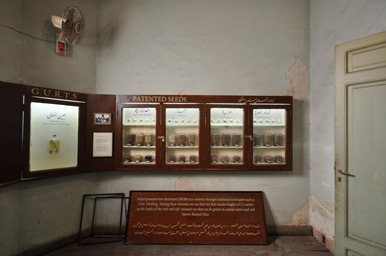WAM _ World Agricultural Museum
WAM is a site-specific work that uses the historical trope of the cabinet of curiosities to explore the introduction of biotechnology in farming.
This 200 square-meter art installation recreates the atmosphere and the colonial aesthetics of the old Agricultural Museum of Cairo, to present the contemporary discourses on genetically modified crops and their various derivatives, coupled with the implementation of intellectual property policies on seeds, international trade agreements and their connection with food insecurity.
The data used to build this narrative is antagonistic, and often contradicts each another. Some emanate from the official scientific discourse, some from peasant organizations, others are a blend of fantasy and propaganda, as well as information generated by supra-governmental institutions such as the FAO, Food and Agriculture Association of the United Nations
The material is presented in a way, in which it is difficult to differentiate fact from fiction. The objects are presented in deliberate disorder, but they are following a very clear hierarchy: the mainstream propaganda pro-GMO backed by multinationals and governments occupy prime locations, while the data provided by independent researchers and farmers associations lays on the floor against the walls.
The museum’s displays hierarchy refers to the unscrupulous and disingenuous ways in which information is orchestrated to seduce the bulk of the citizens, prioritizing data but also concealing it.
On the walls we can see the contours of graphics that has been removed long ago, plenty of empty frames and closed doors bearing signs suggesting what lies behind and remain inaccessible.
WAM is a temporary space illusion, a sort of museum of the future, where the truths of our present reveal their potential obsolescence and the dogmas of our contemporary agricultural progress, covered in dust, seem less gullible.
The artist puts forward the museum as a theatre stage. In an attempt to bricolage the incomplete scenario that reveals the inconsistencies in the hegemonic narrative on food crisis today, the artist plays with the naive and the absurd to stress the ambiguous status quo in the agricultural sector.
The project is conceived as a touring exhibition. It was first assembled in an old apartment located in Downtown Cairo and extended along five of its rooms, was hosted by the Townhouse Gallery and funded by the Spanish Embassy in Cairo and Beca de Movilidad Matadero-Madrid.
text and images by Asuncion Molinos, 2010
WAM (World Agriculture Museum) won Sharjah Biennial Prize in 2015.
ANOTHER PROJECT ON CITYSHARING
→ El Matam El Mish Masry
RELATED WEB SITES
→ pic-book Agriculture Museum
→ article on Agriculture Museum
→ artist’s website
[ 2nd May ]
[ Al Kheimah—The Tent ]
[ Al Maq’ad—The Bench ]
[ Altelefon Alkharban—Téléphone Cassé ]
[ El Ashaa’—The Banquet ]
[ El Matam El Mish Masry ]
[ Ez-zahr—The Dice ]
[ Flatlands Av. ]
[ Here I Stand ]
[ In Memory of Protest ]
[ In the Shadow of the Pyramids ]
[ Mels - A Pause For Thought ]
[ Schaffhauser Rheinufer ]
[ Shwayet mayy—Some Water ]
[ The “Made In Musina” Project ]
[ urbaninform ]
• WAM _ World Agricultural Museum •
FEATURED THEME ON CITY SHARING
by ASUNCION MOLINOS GORDO
-
This project is an instrument for common critical analysis to help understand the reasons behind Egyptians’ diminishing …
by INAS HALABI
-
The project Letters to Fritz and Paul focuses on the expeditions of the Swiss cousins, lovers and scientists, Fritz and …
by SARAH BURGER
-
The planned modern city of Brasilia attracted me since a long time. Her defined shape, location and function proceded he …
by ADRIEN GUILLET
-
Youri Telliug talks with the artist Adrien Guillet about his project Citracit
Youri Telliug - What is Citracit …
by NIGIST GOYTOM
-
In 2013 more than 45 million people have been forced to leave their homes. This amounts to the biggest number of refugees …
by SULAFA HIJAZI
-
The on going debate on Arab identity and its (cultural) representation is strongly shaped by Edward Saidʼs formative …
by ASUNCION MOLINOS GORDO
-
WAM is a site-specific work that uses the historical trope of the cabinet of curiosities to explore the introduction of …
MORE CONTRIBUTIONS BY THE FOLLOWING










